Oort cloud Samenvattingen, Aantekeningen en Examens
Op zoek naar een samenvatting over Oort cloud? Op deze pagina vind je 30 samenvattingen over Oort cloud.
Alle 30 resultaten
Sorteer op
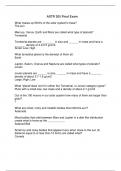 Populair
Populair
-
ASTR 205 Final Exam
- Tentamen (uitwerkingen) • 7 pagina's • 2023
-
Ook in voordeelbundel
-
- $10.00
- 2x verkocht
- + meer info
What makes up 99.8% of the solar system's mass? The sun Mercury, Venus, Earth and Mars are called what type of planets? Terrestrial Terrestrial planets are ________ in size and ______ in mass and have a _______ density of 3.9-5.5 g/cm3 Small; Low; High What terrestrial planet is the densest of them all. Earth Jupiter, Saturn, Uranus and Neptune are called what types of planets? Jovian Jovian planets are ______ is size, ______ in mass and have a _______ density of about 0.7-1.6 g/cm...
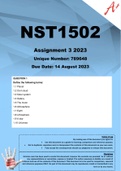
-
NST1502 Assignment 3 2023 (789648)
- Tentamen (uitwerkingen) • 15 pagina's • 2022
-
- $2.81
- 8x verkocht
- + meer info
NST1502 Assignment 3 2023 () 100% TRUSTED workings, explanations and solutions. Whatsapp 067 171 1739 for assistance .............................. QUESTION 1 Define the following terms: 1.1 Planet 1.2 Oort cloud 1.3 Solar system 1.4 Galaxy 1.5 The moon 1.6 Atmosphere 1.7 Earth 1.8 Lithosphere 1.9 A star 1.10 Universe [20] QUESTION 2 2.1 Differentiate between revolution and rotation. (2) 2.2 When considering revolution and rotation, which one creates day and night, and which on...
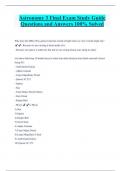
-
Astronomy 3 Final Exam Study Guide Questions and Answers 100% Solved
- Tentamen (uitwerkingen) • 34 pagina's • 2024
- Ook in voordeelbundel
-
- $14.99
- + meer info
Astronomy 3 Final Exam Study Guide Questions and Answers 100% Solved Why does the Milky Way galaxy look like a band of light when we view it in the night sky? ️️- Because we are viewing it from inside of it. - Because our galaxy is relatively flat and we are seeing distant stars along its plane. List these following 10 bodies/areas in order from their distance from Earth outward (closest being #1): - Andromeda Galaxy - Alpha Centauri - Large Magellanic Cloud - Quasar 3C 273 - Ju...
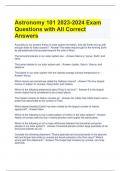
-
Astronomy 101 2023-2024 Exam Questions with All Correct Answers
- Tentamen (uitwerkingen) • 23 pagina's • 2023
-
Ook in voordeelbundel
-
- $13.99
- + meer info
Astronomy 101 2023-2024 Exam Questions with All Correct Answers According to our present theory of solar system formation, how did Earth end up with enough water to make oceans? - Answer-The water was brought to the forming Earth by planetesimals that accreted beyond the orbit of Mars. The terrestrial planets in our solar system are: - Answer-Mercury, Venus, Earth, and Mars. The jovian planets in our solar system are: - Answer-Jupiter, Saturn, Uranus, and Neptune. The planet in our so...
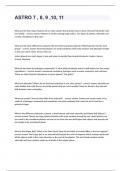
-
ASTRO 7 , 8, 9 ,10, 11 questions with answers 2024
- Tentamen (uitwerkingen) • 7 pagina's • 2024
-
- $12.99
- + meer info
ASTRO 7 , 8, 9 ,10, 11What are the four major features of our solar system that provide clues to how it formed? Describe each one briefly. - correct answer Patterns of motion among large bodies, Two types of planets, asteroids and comets, exceptions to the rules. What are the basic differences between the terrestrial and jovian planets? Which planets fall into each group? - correct answer Terrestrial planets are small and dense with rocky surfaces and abundant metals in the core: Earth, Mars,...
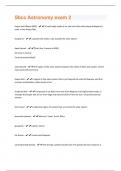
-
Sbcc Astronomy exam 2 Questions With 100% Correct Answers
- Tentamen (uitwerkingen) • 10 pagina's • 2024
- Ook in voordeelbundel
-
- $7.99
- + meer info
Kuiper belt Object (KBO) - A small body made of ice and rock that orbits beyond Neptune's orbit, in the Kuiper Belt. Exoplanet - a planet that orbits a star outside the solar system dwarf planet - Pluto (has 5 moons in KBO) Eris (has 5 moons) Ceres (in asteroid belt) asteroid belt - the region of the solar system between the orbits of Mars and Jupiter, where many asteroids are found Kuiper belt - A region of the solar system that is just beyond the orbit of Neptune and that contains sm...
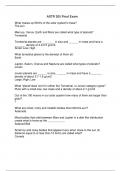
-
ASTR 205 Final Exam
- Tentamen (uitwerkingen) • 7 pagina's • 2023
-
Ook in voordeelbundel
-
- $10.00
- + meer info
What makes up 99.8% of the solar system's mass? The sun Mercury, Venus, Earth and Mars are called what type of planets? Terrestrial Terrestrial planets are ________ in size and ______ in mass and have a _______ density of 3.9-5.5 g/cm3 Small; Low; High What terrestrial planet is the densest of them all. Earth Jupiter, Saturn, Uranus and Neptune are called what types of planets? Jovian Jovian planets are ______ is size, ______ in mass and have a _______ density of about 0.7-1...
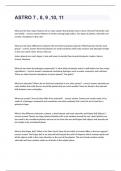
-
ASTRO 7 , 8, 9 ,10, 11 questions n answers graded A+ 2024
- Tentamen (uitwerkingen) • 7 pagina's • 2024
-
Ook in voordeelbundel
-
- $12.99
- + meer info
ASTRO 7 , 8, 9 ,10, 11What are the four major features of our solar system that provide clues to how it formed? Describe each one briefly. - correct answer Patterns of motion among large bodies, Two types of planets, asteroids and comets, exceptions to the rules. What are the basic differences between the terrestrial and jovian planets? Which planets fall into each group? - correct answer Terrestrial planets are small and dense with rocky surfaces and abundant metals in the core: Earth, Mars,...
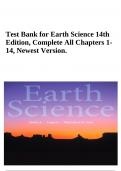
-
Test Bank for Earth Science 14th Edition By Edward J. Tarbuck, Complete All Chapters 1- 14, Newest Version.
- Tentamen (uitwerkingen) • 637 pagina's • 2024
-
- $34.49
- + meer info
Test Bank for Earth Science 14th Edition By Edward J. Tarbuck, Complete All Chapters 1- 14, Newest Version. Chapter 1 Introduction to Earth Science 1) What are the basic differences between the disciplines of physical and historical geology? A) Physical geology is the study of fossils and sequences of rock strata; historical geology is the study of how rocks and minerals were used in the past. B) Historical geology involves the study of rock strata, fossils, and geologic events, utilizing ...
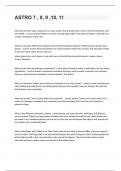
-
ASTRO 7 , 8, 9 ,10, 11 Question and answers 2024 verified to pass
- Tentamen (uitwerkingen) • 7 pagina's • 2024
-
Ook in voordeelbundel
-
- $12.99
- + meer info
ASTRO 7 , 8, 9 ,10, 11 Question and answers 2024 verified to passASTRO 7 , 8, 9 ,10, 11 What are the four major features of our solar system that provide clues to how it formed? Describe each one briefly. - correct answer Patterns of motion among large bodies, Two types of planets, asteroids and comets, exceptions to the rules. What are the basic differences between the terrestrial and jovian planets? Which planets fall into each group? - correct answer Terrestrial planets are small and ...

Vraag jij je af waarom zoveel studenten in mooie kleren lopen, geld genoeg hebben en genieten van tonnen aan vrije tijd? Nou, ze verkopen hun samenvattingen op Stuvia! Stel je eens voor dat jouw samenvatting iedere dag weer wordt verkocht. Ontdek alles over verdienen op Stuvia


